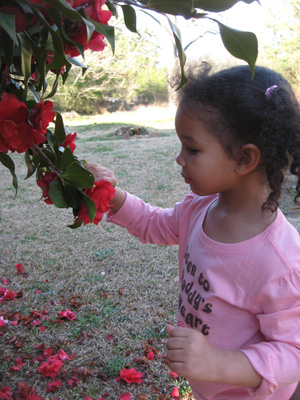G2105
Ages and Stages: 2- and 3-Year-Olds
Two- and three-year-olds are busy, independent, and eager to explore. Learn the milestones of this growth stage and how you can help them develop new and positive skills and abilities.
Leslie Crandall, Mary E. Nelson, Jacqueline M. Guzman, Ruth E. Vonderohe, Gail L. Brand, Marilyn S. Fox, Lisa M. Poppe, LaDonna A. Werth, Extension Educators
Tonia R. Durden, Early Childhood Extension Specialist
Rasheema J. Pitt, Graduate Assistant in Research and Extension
- Physical Development Milestones
- Cognitive Development Milestones
- Social and Emotional Development Milestones
- A Guide for Parents and Caregivers of 2- and 3-Year-Olds
- Resources
The life of a two- or three-year-old is exciting, busy, and very demanding. Two-year-olds have grown to be very independent, using favorite words such as “Mine,” “No,” and “I do it!” as they strive for autonomy. When caring for a two- or three-year-old, enthusiasm, patience, and a sense of humor are most important. This is a time when just exploring can look more like trouble-making to an adult. Fair rules are important; a loving consistent firmness teaches your child the rules of your home. This is a great time to capture your child’s eagerness for learning, so rejoice in your child’s new skills, abilities, and accomplishments. Following are several developmental milestones to consider.
Physical Development Milestones
- Walking without help becomes more successful. Experimenting with walking up and down stairs, walking backward, and standing on tiptoes adds to coordination development.
- Stacking objects, pushing, pulling, filling, dumping, kicking, pedaling, tossing, and rolling items increases large motor skills.
- Using crayons and markers will increase finger dexterity and learning to feed oneself will develop coordination.
- A full set of teeth allows children to explore a whole new set of foods.
Cognitive Development Milestones
- Words and sentences become important. Two- to three-word sentences are common.
- More words are understood than are spoken.
- Simple stories, rhymes, and songs are enjoyed and their repetition is important.
- Mimicking mommy and daddy helps young children learn how to work and how to use utensils and tools.
- Simple directions can be followed. Give them easy chores such as “Wash your face,” “Brush your teeth,” “Put the silverware on the table,” and “Tear the lettuce for a salad.”
- They begin to sort objects by color and shape.
Social and Emotional Development Milestones
- Children are beginning to observe and learn positive and appropriate social skills and may experience a full range of emotions such as empathy, frustration, caring, unpredictability, friendliness, etc.
- Sharing is a learned trait and many children at this age are very possessive. They may offer toys to other children, but then want them back.
- Two- and three-year-olds may tend to be bashful or shy around strangers.
- They may resist major changes in their daily routines (for example, napping, eating, and playtime).
|
A Guide for Parents and Caregivers of 2- and 3-Year-Olds
- Children really rely on their senses when exploring and learning about their world. They love to smell, taste, and touch (Figure 1). If you give your child plenty of fun-to-feel materials to keep their hands busy, they will develop strength, agility, and fine motor skills.
- Because children can identify body parts, shapes, words, and colors at this age, adults can help them further enhance their vocabulary by pointing to new objects and pictures in the immediate environment. This increases the 200-300 words that they are already familiar with.
- Imitation and make-believe play are important at this age. Parents need to allow for make-believe friends and role playing, which helps the child better understand the social expectations of society.
- Young children are beginning to demonstrate and assert their independence. Encourage self-help skills such as using the toilet independently, eating with a spoon, and putting on some items of clothing by themselves.
Resources
Books
Fun to Play, Ready to Learn Activity Guide (EB2), University of Nebraska–Lincoln Extension, 2007.
Ages and Stages for Caregivers, 2 Years (ASC-6-02) by Mary F. Longo, Kathy L. Reschke, and Cheryl Barber, Ohio State University, 2002.
Ages and Stages for Caregivers, 3 Years (ASC-7-02) by Mary F. Longo, Kathy L. Reschke, and Cheryl Barber, Ohio State University, 2002.
2 Year Olds, Ages and Stages by Lesia Oesterreich, Iowa State University (2008).
3 Year Olds, Ages and Stages by Lesia Oesterreich, Iowa State University (2008).
Websites
Center for Disease Control and Prevention: Infants and Toddlers, http://www.cdc.gov/parents/infants
Parenting and Just in Time Parenting Newsletter: www.extension.org/parenting Use code: NE10JITP
UNL Extension Child and Youth Development: http://www.extension.unl.edu/web/child
UNL Extension Building Better Children Facebook page: http://www.facebook.com/buildingbetterchildren
Zero to Three: National Center for Infants and Toddlers: www.zerotothree.org
This publication has been peer reviewed.
Visit the University of Nebraska–Lincoln Extension Publications website for more publications.
Index: Families
Childhood
Issued November 2011
